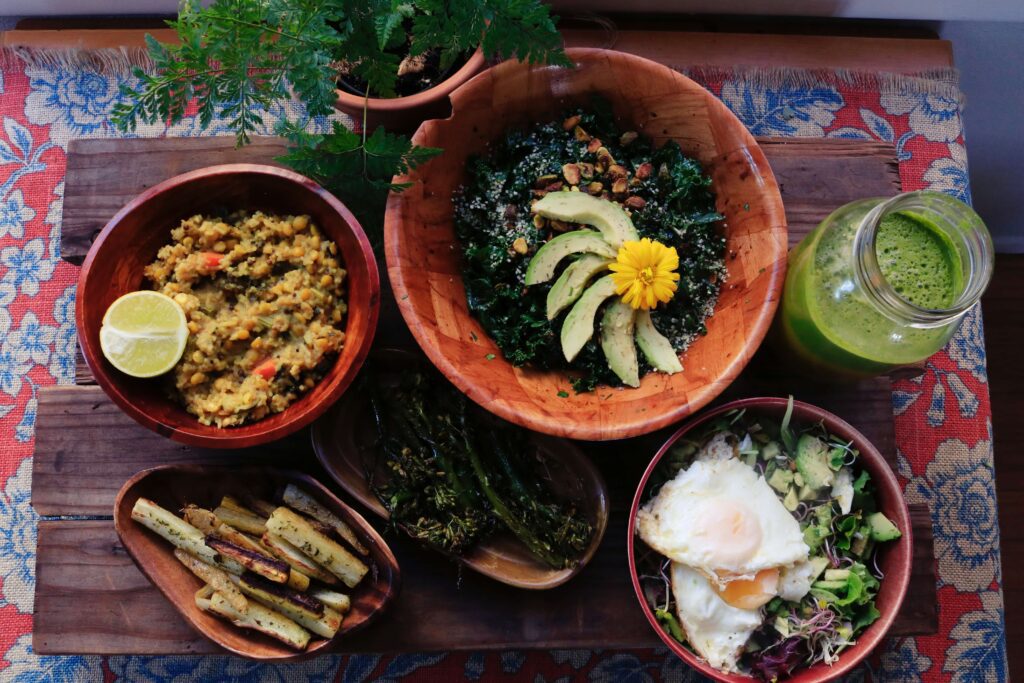A Crash Course in Ayurveda + Nourishing Foods for Your Dosha

Ayurveda is a system of medicine that has been around for at least 10,000 years. In fact, the oldest forms of recorded human history describe Ayurveda in what are now known as The Vedas. It’s often referred to as the sister science of yoga, which has certainly gained traction in our modern society yet Ayurveda is still relatively esoteric. There’s a chance you’ve heard of the doshas by now (perhaps from an online quiz or something of that nature) but there are so many other principles of the ancient system of Ayurveda that we can learn from today. So consider this your crash course and, if you want to go deeper, listen to our full conversation with Dr. Bhaswati Bhattacharya, MD.
Gunas
In Ayurveda, everything in the universe can be described in terms of its attributes, or gunas. There are 20 gunas in total, organized into 10 pairs of opposites. Interestingly, each dosha (which we will get to next) has its own unique set of gunas associated with it. The 20 gunas are:
- Heavy (Guru) – Light (Laghu)
- Cold (Sita) – Hot (Usna)
- Oily (Snigdha) – Dry (Ruksa)
- Dull (Manda) – Sharp (Tiksna)
- Smooth (Slaksna) – Rough (Khara)
- Dense (Sandra) – Liquid (Drava)
- Soft (Mrdu) – Hard (Kathina)
- Stable (Sthira) – Mobile (Cala)
- Gross (Suksma) – Subtle (Sthula)
- Cloudy (Visada) – Clear (Picchila)
Doshas
There are three doshas in ayurveda which you can think of as constitutions or body types. While we are typically dominant in one dosha, all three are present in each of us just in different ratios.
Pitta
The element associated with pitta is fire. Pitta is the force responsible for your digestion and transformation. People who are mainly pitta typically have a muscular build, medium frame, fast metabolism and strong appetite. They often are ambitious, intelligent and strong-willed. Pitta types love challenges and are courageous and strong in their endeavors. When unbalanced, pitta can manifest as inflammation (particularly in skin issues), diarrhea, heartburn, and other “hot” symptoms in your body.
Supportive foods for pittas: cooling vegetables and herbs, sweet fruits (like melon, grapes), milk, butter, ghee, coconut water, grains. Avoid hot, spicy or fermented foods (including fermented dairy) and sour fruits or vegetables.
Vata
The element associated with vata is air. Vata is the force that controls your movement and communication. People who are mostly vata tend to be thin and narrow in build, they run cold, and have dry hair and skin. Vatas are energetic, restless, creative and spontaneous. They hate sitting still and much prefer getting out and about, even if there’s no real goal other than to move their bodies. When out of balance, vata can show up as anxiety, insomnia, feeling ungrounded, internal dryness (constipation, dehydration) and dizziness.
Supportive foods for vatas: Grounding, warming foods like root vegetables, warm spicy drinks (like golden milk), cooked/stewed meats, and lots of healthy fats. It’s also important for vatas to stay super hydrated as they are prone to dryness and dehydration.
Kapha
The element associated with kapha is water. Kapha is the force in charge of cohesiveness, lubrication and structure. People who are predominantly kapha usually have a heavier build, slower metabolism, calm demeanor, radiant skin and thick hair that runs on the oilier side. Kaphas are elegant, patient, compassionate and have incredible stamina. Unlike vata types, kapha types are quite content resting or spending time in stillness. When out of balance, kapha can manifest as brain fog, laziness, edema, jealousy and weight gain.
Supportive foods for kaphas: Bitter, sour, pungent, and astringent things like leafy greens, fermented foods, lentils, beans, turmeric, cranberries, pomegranates and all digestive herbs. Since kapha types are already quite oily, avoid oily foods and opt for drier ingredients (especially when it comes to animal protein).
Srotamsi
The srotamsi are essentially Ayurveda’s way of understanding and categorizing the different body systems. A srotas, which means river in Sanskrit, is a channel through which nutrients and other materials flow through your body. In Ayurveda, the srotamsi may transport fluid, food, waste, blood and toxins, depending on which srotas you are looking at. For instance, the Anna Vaha Srotas carries food while the Rakta Vaha Srotas moves blood. Structurally, each srotas has a root (sroto mula), passage (sroto marga), and opening (sroto mukha). An important thing to know here is that there are four main ways that the srotas can become dysfunctional:
- Ati pravrutti: excess flow (like urination)
- Sanga: obstruction or stagnation
- Vimmarga gamana: reverse flow
- Sira granthi: growth, tumors, swelling
Ayurvedic practitioners use these benchmarks to assess the functioning of a person’s srotas and to determine how to get them healthy and clear again with the help of diet, lifestyle changes and balancing the doshas.
Want more support in eating healthier and losing weight?
By working with one of our Registered Dietitian Nutritionists at Michelle Shapiro Nutrition LLC, you will receive personalized recommendations and one-on-one nutritional counseling to help you reach attainable goals in a way that fits your lifestyle.